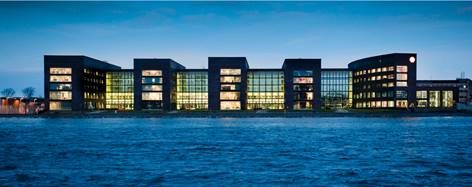Stuart Nathan
Features editor
A briefing at Shell revealed that the oil giant is considering the distant prospect of the end of extractable hydrocarbons, including one of the most striking examples of recycling we've ever come across.
Yesterday found me at the Shell Technology Centre Amsterdam, finding out about some of the Anglo-Dutch oil and gas giant’s latest innovations. It was a fascinating grounding into an industry that, while its many critics might like to hint is on its last legs, still certainly seems to have an abundance of gas in its tank (if you’ll pardon the metaphor).
I’ll go into much more depth in our upcoming issue’s cover feature, but two things in particular were very apparent from yesterday’s visit: the obvious and unfakeable enthusiasm of the engineers working at the STCA, and the willingness of the spokespeople to discuss options beyond hydrocarbons.

In the case of the first, we obviously expect the people who’ve been selected to make presentations to the press to put on an enthusiastic front. But that isn’t always the case when it comes to tours of the facilities. People who’ve been pulled away from their work to tell strangers about what they do every day aren’t always the best presenters. That’s fine; we don’t expect them to be. But the STCA staff went beyond the call of duty to introduce us to complex concepts and show us the inner workings of their laboratories, pilot plants and analysis equipment.
What was also obvious is that Shell is thinking beyond hydrocarbons. One presenter told us frankly that, in many ways, hydrogen would make a better fuel for road transport even than liquefied natural gas, which was the subject of his presentation. ‘Hydrogen is the end-point and we have some large-scale studies under way,’ he said.

LNG is clearly a major focus for Shell, which is currently building its mammoth Prelude floating LNG (FLNG) plant at Geoje in Korea. At 488m long and displacing 600,000tonnes (five times as much as the largest US aircraft carrier), Prelude will be the largest floating object ever constructed. It’s planned to be stationed 200 miles off the coast of Western Australia to turn the gas from remote fields into LNG as it’s produced, to reduce the cost of transporting it to its markets (LNG has a volume 600 times smaller than gas).
Prelude was one of the first projects launched by Shell’s GameChanger programme, which attempts to derisk the development of future-oriented technologies so that they are a more attractive investment. Another GameChanger is GlassPoint, which produces concentrating solar power plants designed to be located inside giant greenhouses, to protect them from the harsh sandy and windy conditions of deserts. The point of these installations is to produce carbon-free steam to extract oil from remote fields that would otherwise require large amounts of energy to produce, whose carbon profile might outweigh the benefits of clean-burning natural gas. It’s an interesting insight into some of the thinking of a hydrocarbon giant.

Even more striking was an aside during a presentation about the future of gas. Shell’s expertise in gas-to-liquids technology is well-known, with its Pearl plant in Qatar one of the world’s largest facilities for transforming gas into tailored hydrocarbons for sulphur-free, clean-burning fuels, advanced lubricants and waxes. This technology is based on an advanced version of the venerable Fischer-Tropsch process, which builds hydrocarbon molecules from the mixture of hydrogen and carbon monoxide known as synthesis gas or syngas. One option currently being studied by Shell at a very early stage is to use renewable electricity to produce hydrogen by electrolysing water and then use a system known as reverse water-gas shift to convert atmospheric carbon dioxide (which is chemically inert) and hydrogen into reactive CO. This could then be converted back into burnable fuels using a GTL system.
The costs of this are, of course, unknown; but the studies are at a very early stage. Oil and gas companies exist to sell things that burn; and it’s very intriguing to discover that one of them, at least, is considering ways to turn stuff we’ve already burned into stuff that will burn again, and sell it back to us. Now that’s an example of a circular economy.





Red Bull makes hydrogen fuel cell play with AVL
Formula 1 is an anachronistic anomaly where its only cutting edge is in engine development. The rules prohibit any real innovation and there would be...